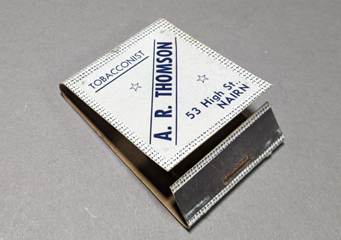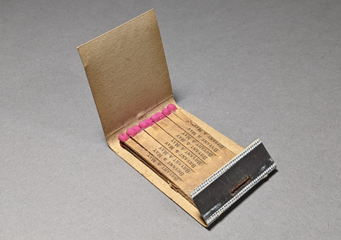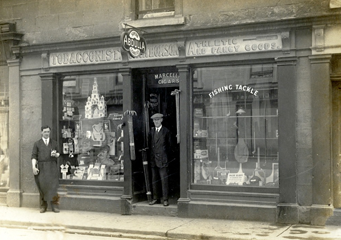New Discoveries
Find out more about the new discoveries that we have made in the museum archives and from the local area.
Do you have any more information about any of the items below? If so, we would love to hear from you. You can email us at manager@nairnmuseum.co.uk or phone us on 01667 456791.
January 25th, 2022 - Book of matches from Tobacconist, A.R. Thomson


Here we have a cardboard book of matches from Tobacconist A.R. Thomson, whose premises were located at 53 High Street Nairn. The matches are made by Bryant and May, with pink tops, detached from the cardboard.
We are lucky to have been able to hear from Sandra Ross about her memories of the shop. Sandra is the niece of Pearl Thomson, whose father, Frank Thomson, owned the business. According to Sandra the shop stocked 107 types of loose tobacco in jars, as the local farmers who bought their tobacco from Thomson’s Tobacconist all liked their own brand. As well as this impressive selection of tobacco, the shop also sold cigarettes, pipes of all sizes, snuff, walking sticks and shepherd’s crooks, silver cigarette and snuff boxes and fireworks for bonfire night. In the 1960s the shop began to stock toys and their toy department was located in the basement.

Sandra remembers the shop as a popular meeting place for many Nairn folk, with 4pm being the time that many of them met up. Some of those who journeyed in from the country left their shopping until later in the day when they were ready to return home as there were not so many cars in times gone by. Perhaps some people would have finished work around that time too. Late afternoon would therefore have been a busy and sociable time for the tobacconist.
Thanks to Sandra for contacting us with the memories she has of A.R. Thomson. If you have any more information that you would like to pass on to us, please get in touch.
January 18th, 2022 - Horn Spoon from Culbin Sands

We have in our collection a horn spoon that was found at Culbin. Culbin Sands is an area along the coast of Moray and Highland which comprises coastal sandbars, sand dunes and a modern forestry plantation. In the past, however, the area was home to a thriving community which is where we presume our horn spoon originates from.
With a history stretching back to the 13th century, Culbin was a fertile area and those who settled there enjoyed rich pasture for their animals, fertile fields for their crops and the bounty of the river Findhorn. Unfortunately, in the latter half of the 17th century, disaster struck the community. In an account written by Sinclair Ross, (The Culbin Sands – A Mystery Unravelled), we learn that in autumn 1694, a great sand drift came suddenly from the west and buried much of the land and buildings with some inhabitants becoming trapped in their homes. The following day, having broken out of the buildings, the people saw the storm intensify once again and this time the inhabitants were forced to flee for their lives. From that day onwards their settlement lay buried under the sand and remains so to this day.

Our wee horn spoon is a reminder of the community that once thrived there and makes us wonder what other objects may still be lying buried. In the future maybe some more will find their way to Nairn Museum.
If you have any more information about our horn spoon that you think we would find interesting, please get in touch.